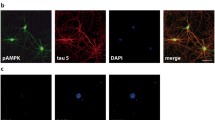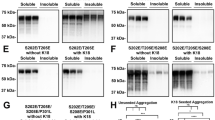Summary.
Calcium/calmodulin-dependent kinase II (α- and β-CaM kinase II), and phosphorylated mitogen-activated extracellular signal-regulated protein kinase (MAPK/ERK-P), phosphorylated protein kinase of 38 kDa (p38-P) and phosphorylated stress-activated protein kinase (SAPK/JNK-P) expression have been examined in Alzheimer disease (AD), Pick's disease (PiD), progressive supranuclear palsy (PSP) and corticobasal degeneration (CBD). The study was carried out to increase understanding of the signals that may regulate tau phosphorylation in tauopathies. MAPK/ERK-P was found in a subset of neurons and glial cells bearing abnormal tau deposition, but rarely in neurofibrillary tangles. Strong p38-P immunoreactivity was observed in about 50–70% of neurons with neurofibrillary tangles and in dystrophic neurites of senile plaques in AD. Strong p38-P immunoreactivity was seen in practically all Pick bodies in PiD, and in most neurons with neurofibrillary degeneration or with tau deposits (pre-tangle neurons) in PSP and CBD, as revealed with single and double-labeling immunohistochemistry to p38-P and tau. In addition, strong p38-P immunoreactivity was present in tau-positive astrocytes and in coiled bodies in PSP and CBD. Single and double-labeling immunohistochemistry to MAPK/ERK-P and p38-P disclosed that MAPK/ERK-P appeared at early stages of tau phosphorylation in neurons and glial cells in tauopathies, and that MAPK/ERK-P and p38-P co-localize only in a subset of neurons and glial cells with phosphorylated tau deposits. SAPK/JNK-P immunoreactivity was seen in a subset of neurons, including many neurons with neurofibrillary degeneration, and in glial cells accumulating abnormal tau, in AD, PiD, PSP and CBD. Double-labeling immunohistochemistry disclosed partial co-localization of SAPK/JNK-P and either MAPK/ERK-P or p-38-P immunoreactivity. These findings indicate that MAPK/ERK-P, SAPK/JNK-P and p-38-P are differentially expressed in association with tau deposits in tauopathies. Finally, CaM kinase II is present in neurons but not in glial cells, thus suggesting no role of CaM kinase II in tau phosphorylation of glial cells. These observations, together with previous results of in vitro studies, support the idea that several MAPK/ERK, SAPK/JNK, p38 and CaM kinase II may participate in tau phosphorylation in tauopathies. Lack of co-localization between MAPK/ERK-P, SAPK/JNK-P and p-38-P over-expression, and staining with the method of in situ end-labeling of nuclear DNA fragmentation in individual cells indicate that over-expression of these kinases is not linked with increased nuclear DNA vulnerability in AD, PiD, PSP and CBD.
Similar content being viewed by others
Author information
Authors and Affiliations
Additional information
Received June 26, 2001; accepted August 27, 2001
Rights and permissions
About this article
Cite this article
Ferrer, I., Blanco, R., Carmona, M. et al. Phosphorylated mitogen-activated protein kinase (MAPK/ERK-P), protein kinase of 38 kDa (p38-P), stress-activated protein kinase (SAPK/JNK-P), and calcium/calmodulin-dependent kinase II (CaM kinase II) are differentially expressed in tau deposits in neurons and glial cells in tauopathies. J Neural Transm 108, 1397–1415 (2001). https://doi.org/10.1007/s007020100016
Issue Date:
DOI: https://doi.org/10.1007/s007020100016




